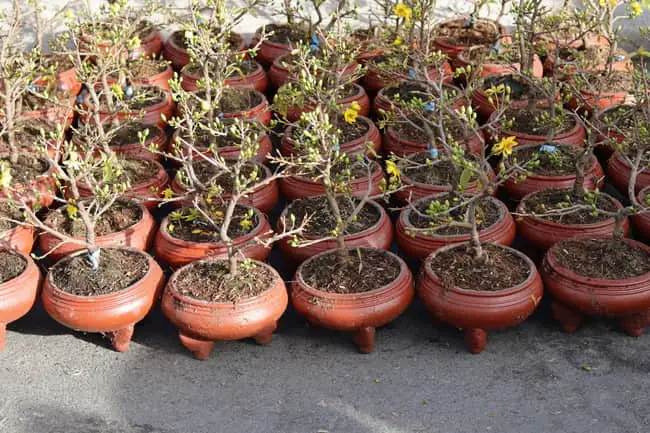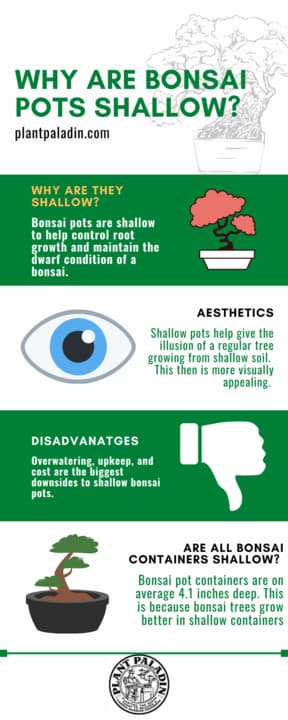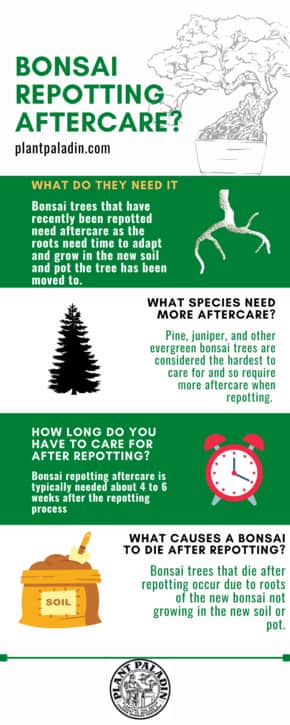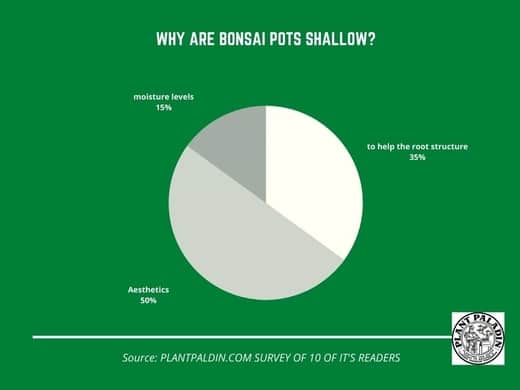This website is supported by its readers. If you click one of my links I may earn a commission. I am also a participant in the Amazon affiliates program and I will also earn a commission from qualified purchases.

So recently, as the summer comes to an end, I managed to repot the last of my bonsai. As such I’ve been paying extra close attention to the pots I repot my bonsai in. One of the questions I used to have was why are bonsai pots shallow?
Bonsai pots are shallow to help control root growth and maintain the dwarf condition of a bonsai. Shallow bonsai pots also hold on to water better, creating a healthier atmosphere. Shallow pots also help with the overall aesthetic of a miniature tree, helping create nebari.
So what are the other benefits of having a shallow bonsai pot? And exactly how shallow should a shallow bonsai pot be? Keep reading to find out more.
Just a quick heads up, over the past three years of running Plantpaladin, hundreds of people have asked for product recommendations. As such, You can find my favorite indoor bonsai tree here (link takes you to Bonsaiboy), my favorite outdoor bonsai tree (link takes you to Bonsaiboy), or have a look at all the products I recommend here.
What are bonsai pots so shallow?
One of the most confusing aspects of bonsai when I first got started was the depth and shallowness of bonsai pots.
I was used to growing small plants like strawberries or other common garden plants such as sunflowers and daffodils – all of which required regular deep pots.
So why did bonsai pots need to be shallow?
Well, luckily I visited a few of my local botanical gardens, asked a few bonsai experts, have been growing bonsai for the past 3 years, and even asked 20 plant paladin readers their thoughts on shallow pots.
These were the main conclusions and advantages then as to why are bonsai pots shallow are:
- Aesthetic reasons
- Helps with nebari
- Better water retention
- Easier to repot
- Helps the root growth
- Maintains the dwarf condition of a bonsai
- Helps bonsai seedlings
- Easier to move around
Let’s explore these in more detail.

Aesthetics
Without a doubt, the biggest reason that bonsai tree pots are so shallow is for aesthetic reasons.
The word bonsai literally means planted in a container in Japanese.
The whole purpose of growing bonsai then is to grow miniature trees artificially that mimic the look of regular trees in the wild.
If you were to use a regular 30cm tall pot to keep your bonsai in, something would feel off, with the tree not looking like a bonsai tree.
Shallow pots help give the illusion of a regular tree growing from shallow soil.
This then is more visually appealing to the eye and helps give the naturalistic look that bonsai trees go for.
On top of this, shallow bonsai tree pots come in a variety of sizes and colors meaning they can be matched to the exact aesthetic of your bonsai, further aiding in the illusion of a miniature tree.
Helps with nebari
Nebari, also known as root flair or surface roots, is the part of the bonsai where the roots extend from the topsoil.
Often the more nebari a bonsai tree has, the more aesthetically pleasing it will be.
Strong bonsai nebari can also help maintain a strong bonsai trunk and ensure that your tree has a strong foothold in the soil.
Now nebari is often created by wrapping a copper wire around the bottom of the bonsai trunk, cutting off the circulation to the tree, and increasing the trunk, branch, and root size.
Planting your bonsai in shallow, wide pots then can aid in the creation of nebari by not offering your tree any downward growth, forcing the roots to grow upwards.
This will push the roots through the topsoil creating a strong nebari.
Better water retention
One of the biggest things we bonsai owners have to learn when it comes to bonsai tree keeping is that bonsai requires a lot more water than other types of trees.
Bonsai comes in a variety of sizes and it’s not uncommon for bonsai trees to dry out several times a day – especially for smaller fingertip-sized bonsai.
Now if you were to plant bonsai in a regular plant pot, there would be too much excess soil, meaning that the water would simply not be able to be properly absorbed by the roots of your tree.
Shallow bonsai pots however are a different story.
As the water has a smaller surface area to move around in, the water will simply be absorbed directly by the roots.
Any excess water will typically be passed out through the drainage holes in a bonsai pot.
Easier to repot
Repotting bonsai is a common part of any bonsai owner’s journey.
Every 2 -3 years most bonsai species will need to be repotted.
Repotting bonsai can be a lot of work, especially if you have a lot of soil or large root systems that need to be removed.
Should you grow your bonsai in a larger plant pot with more depth, this will mean your bonsai will have a more spread out root system, and often a lot more soil will be clumped together with these roots.
This will make it more difficult to repot, often taking a few hours to untangle the mess.
The more time spent outside the soil the smaller chances of success your bonsai will have at taking to its new pot.
One of the best things you can do then is to keep your bonsai in a shallow pot.
Not only will you have less surface area to deal with, meaning removing the bonsai from a shallow pot will typically take a few minutes and not hours on end.
The root systems in shallow pots tend to clump together into a root ball, making it a lot easier to repot too.
Helps the root growth
We’ve talked about this already a few times in this post but another major advantage to keeping bonsai in a shallow pot is that it helps the root growth of your tree.
Bonsai tree keeping is all about giving the illusion of a miniature tree.
This is done with a lot of defoliating and creating great bonsai ramification, but often the most important factor that comes with this is creating a tight root network.
Should you plant your bonsai in a large plant pot, the roots will grow downwards instead of staying shallow.
This will stop your tree from creating nebari, make it more difficult to manage when repotting your bonsai and more often than not, just make your tree grow naturally as opposed to maintaining its dwarf form.
Maintains the dwarf condition of a bonsai
The major difference between growing a bonsai tree and growing a regular tree is that bonsai trees are planted in pots.
Now if you were to plant a regular tree seed in a regular plant pot, eventually this would grow and not become a bonsai but a small tree.
Growing a seed however in a shallow pot will force your tree into a bonsai through the root structure of the tree.
Keeping your bonsai tree in a shallow pot for its first few years (up until it is about 20 years old) will stop the tree from just growing into a regular tree should you decide to plant it in the ground after then too.
Helps bonsai seedlings
Similar to the point above, keeping a bonsai in a shallow pot will ensure it grows into a bonsai and not a regular plant or tree.
This is more apparent than when growing a bonsai from scratch – either from a seedling or bonsai cuttings.
If then you were to plant these seedlings or cuttings into a regular size plant pot – in almost all circumstances they would not grow into bonsai but regular trees.
Growing bonsai in shallow pots, with inorganic soil mixes, will ensure your seedling or cuttings have the best chance of success in turning into full-grown bonsai trees.
Just be sure that any repotting you takes into consideration the significant aftercare process required.

Easier to move around
Finally, bonsai trees are often moved around a lot, either for cleaning, moving them into direct sunlight, or preparing them for winter by moving them into greenhouses or cold frames.
As such, shallower smaller pots will be easier to move around than moving a big deep pot.
What are the disadvantages of having shallow pots for bonsai?
So throughout this post, we have covered the main advantages (justifiably so) as to why you should keep your bonsai in a shallow pot.
But are there any disadvantages to doing so?
The main three I have come across include:
- Cost
- Overwatering
- Upkeep
Let’s explore these below
Cost
Bonsai keeping is an expensive habit to get into with the trees usually going for upwards of $100 for a beginner level tree.
This is also true when it comes to bonsai pots with premium or antique shallow bonsai trays or pots selling for hundreds of dollars.
Whilst you can find shallow bonsai pots on sites like Amazon for a lot less, it will often be hard to find the exact color and size that you need to match your tree’s aesthetics.
As such, the price can add up.
Overwatering
Whilst shallow pots are fantastic at water retention, if you live in a wetter climate, then there is a good chance that you can potentially overwater your bonsai.
This is especially true if you keep your bonsai outdoors, have prolonged rainfall for a few weeks on end, or use mosses like sphagnum moss to further aid the moisture on your tree.
This much water can also lead to other problems such as attracting unwanted pests like insects or slugs and even frogs to your tree.
The good news however is that you can overcome this.
Shallow bonsai pots usually are easy to tailor to your needs so you can add more drainage holes if need be.
Number of drainage holes vs the size of a bonsai
| Classification | Size inches | Number of penny-sized holes | Number of pencil-sized holes |
| Keshitsubo | 1 to 3 inches | 1-2 | 0 |
| Shito | 2 to 4 inches | 1-2 | 0 |
| Mame | 2 to 6 inches | 2 | 2 |
| Chohin | 5 to 8 inches | 2 | 2 |
| Kumono | 6 to 10 inches | 2 | 2 |
| Katade-mochi | 10 to 18 inches | 2 | 3 |
| Chiu or Chumono | 16 to 36 inches | 2 | 4 |
| Dai or Omono | 30 to 48 inches | 3 | 6 |
| Hachi-uye | 40 to 60 inches | 4 | 8 |
| Imperial | 60 to 80 inches | 6 | 8 |
Secondly, if you have overwatered your bonsai tree in a shallow pot, I would recommend checking out the following posts to help counteract this:
Upkeep
The final disadvantage when it comes to keeping bonsai in shallow pots is the upkeep.
Bonsai trees need to be repotted every few years meaning that the shallow pots you keep them in will no longer be of use once you are done with them.
This means that unless you plan to sell your shallow bonsai pots, or have a large collection of trees, you will have a lot of wasted pots after a decade or so of keeping bonsai.
Now it can be difficult getting an understanding of how fast bonsai trees grow in shallow pots or how often they will need to be repotted, so hopefully, the table below will help:
| Bonsai species | When to repot? |
| Chinese Elm | 1-2 years |
| Juniper | 3-5 years |
| Jade | 2-3 years |
| Maple | 3-5 years |
| Fukien Tea | 2-3 years |
| Ficus | 2 years |
| Wisteria | 3-5 years |
| Cotoneaster | 1-2 years |
| Pine (most varieties) | 3 to 5 years |
| Azalea | 3 years |
How big should a shallow bonsai pot be?
Shallow rectangular bonsai pots should be at least ⅔ as wide as the height of the tree. Shallow round pots, the diameter of the pot should be ⅓ the height of the tree. Shallow bonsai pots should aim to be ⅓ as deep as they are wide.
Where can you get shallow bonsai pots?
Good shallow bonsai pots can be purchased from any good bonsai retailer or outlet.
For my money, however, there is no better option than to get your shallow bonsai pots from eastern leaf.
They have a wide selection of pots, of varying depths to ensure you get the right size for you.
How do bonsai trees grow in shallow pots?
Bonsai trees grow in much the same way that normal trees do in shallow pots.
Once the seedling or cutting has been planted, new shoots, roots, and growth will start to occur in the tree.
With enough watering and care the seedling or cutting will then grow into a full-grown bonsai tree after 15 years or so.
The major difference however comes with the growth of the roots.
Bonsai roots will be restricted by their growth in shallow pots, meaning that instead of growing downwards, the root systems stay shallow and close to the tree in the pot.
This in turn creates great bonsai nebari and prevents a bonsai tree from growing into a regular-sized tree.
Are all bonsai containers shallow?
The majority of bonsai pot containers are shallow. On average they are 4.1 inches deep. This is because bonsai trees grow better in shallow containers, mimicking the look of a natural tree whilst optimizing the moisture levels and nebari a tree grows.
What bonsai tree species need deep pots?
Whilst the majority of bonsai tree species will benefit greatly from being kept in shallow pots there are a few species that benefit from being kept in deeper species.
Bonsai tree species such as trident maple, crabapple, and other fruit and flower-bearing species will often need deeper bonsai pots. This is because they have fast-growing root systems that will be too difficult to be managed in smaller shallower pot sizes.
Bonsai species that require a lot of water than normal such as Fukien tea or oak will benefit from shallow pots.
How shallow are bonsai pots?
The average depth of a bonsai pot is 4.1 inches deep. Smaller bonsai pots are typically 3.5 inches deep. Medium-sized bonsai pots are typically 4.8 inches deep. Larger-sized bonsai pots are 4.25 inches deep.
To help find this out, I compared 12 different-sized bonsai pots and came up with the following results.
| Brand | Size | Catagory | Depth |
| Happy Bonsai | Small
(5.9 x 5.1 x 2.0 in) | Cheap | 2 inches |
| Herons Bonsai | Small
(7.4 x 5.7 x 0.9 in) | Cheap | 0.9 Inch |
| Yixing purple sand | Small
(10.6 x 8.46 x 8.14 in) | Mid-market | 8.14 inches |
| Antique Lingnan bonsai pot | Small
(6.8 x 4in) | Premium | 4 inches |
| Herons Bonsai | Medium
(17.5 x 12.5 x 5.1 in) | Cheap | 5.1 inches |
| Eastern Leaf | Medium
(14.5 x 11 x 3.5 in) | Mid-market | 3.5 inches |
| Yixing purple clay | Medium
(18.5 x 14.9 x 4.9 in) | Premium | 4.9 inches |
| Kanji | Medium
(13.4 x 20.1 x 5.7 in) | Premium | 5.7 inches |
| Kaizen Bonsai | Large
(21 x 14 x 3 in) | Cheap | 3 inches |
| Yorkshire Bonsai | Large
(27 x 15 x 2.7 in) | Mid-market | 2.7 inches |
| Etsy | Large
(22.3×17.71×6.22 in) | Premium | 6.2 inches |
| SEIBUN | Large
(16 x 14.1 x 5.1 in) | Premium | 5.1 inches |
Should I keep my bonsai in a shallow pot?
The majority of bonsai trees should be kept in shallow bonsai pots. This will help maintain the size of the bonsai once fully mature. Flowering or fruit-bearing species of bonsai such as Crabapple bonsai may require slightly deeper bonsai pots due to their fast-growing roots.
Survey results
Now I didn’t just want to give my opinion on why bonsai pots are shallow and so I got in touch with one of the bonsai experts from Birmingham Botanical Gardens on my local visit and this is what they said:
“Most of our bonsai trays are fairly shallow. This is to help maintain the size of the trees. A lot of our trees are coming up to 100 years old so we don’t want to make any changes to them”
I also did a survey of 20 plant paladin readers asking them why they keep their bonsai trees in shallow pots – here were the results:

My top picks for the gear you will need!
So like I mentioned earlier, over the past three years of running PlantPaladin, hundreds of people have asked me for my recommendations on the best bonsai gear on the market.
Having spent thousands of dollars on bonsai items these past few years and tested at least 100 bonsai-specific products, I’ve listed my favorite products below – All of which I highly recommend and think you can get great value.
They can purchase directly by clicking the link to take them to Amazon.
Bonsai Tool Set: One of the significant challenges I’ve had is finding a toolset that was not only durable but didn’t break the bank. SOLIGT has recently developed a fantastic bonsai tool set that covers all the tools you need to trim, prune, and repot your trees. – You can grab it here.
Complete Bonsai Set: Many of you will want to grow your bonsai trees entirely from scratch, but finding the varicose seeds, pots, and other items in one place can be challenging. Leaves and Sole then have created a complete bonsai set that I’ve personally used that ticks all the boxes. You can grab it here.
Bonsai wire: The number of times I’ve run out of wire for my bonsai or purchased cheap bonsai wire that doesn’t do the job is embarrassing for me to admit. After a lot of trial and error, I found that using Hotop’s aluminum bonsai wire is one of the best options on the market. This can easily be used for both indoor and outdoor bonsai. You can grab it here.
This post was written by Fehed Nicass who has been passionate about bonsai for over 3 years.
